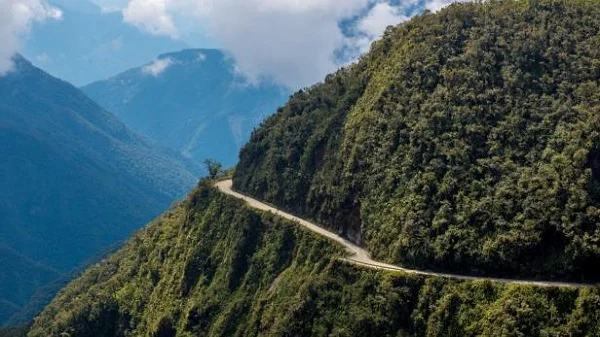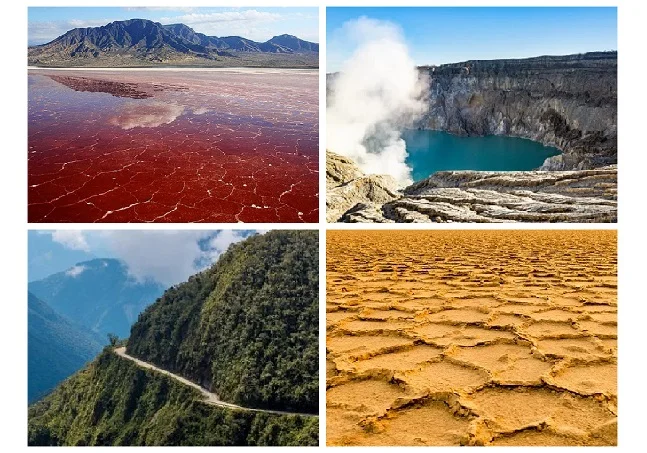Landscapes of the Earth are amazing; they make people travel to the end of the world. But there are many places where the utmost care should be taken. Many careless tourists have died or lost their health, underestimating the danger of these parts of the planet.
Most dangerous places on Earth
Death Road, Bolivia

The most dangerous mountain road in the world is located in Bolivia, its length is almost 70 kilometres, and the highest section reaches 3.6 kilometres. This road is the only route connecting the town of Coroico and La Paz.
It is so narrow that the wheels of passing trucks and buses almost slide into the abyss in some places. There is a rock on one side; on the other, there is an abyss with a height of 600 meters. Tragic incidents occur here regularly: every year, an average of 26 buses fall into the abyss, and about 300 people die.
Surprisingly, tourists love this place for its adrenaline-filled bike tours. But even on a bicycle, you cannot lose your attention for a second because the road is very rocky. It is difficult to forget about the danger of this place – there are crosses along the road, and the “remains” of cars that did not fall are rusting.
Bermuda Triangle, Atlantic Ocean
The most dangerous places on the planet are paranormal, such as the Bermuda or Devil’s Triangle between American Florida, the island state of Puerto Rico and Bermuda. The mystery began to deepen in 1950 when materials about the disappearance of 14 Avenger military aircraft in 1945 were published.
One seaplane did not return to base from the search. In 1965, an aircraft with a crew of 10 disappeared. For 100 years, about 100 facts of dissolution of water and aircraft in space have accumulated, and even more cases of disappearance of the crew, passengers of good ships in the open ocean have accumulated.
Danakil Desert, Ethiopia
This place is also called “Hell on Earth.” It got this name because of the incredible heat, which reaches 50 ° C, and the gases that poisonous vapours escape from the earth’s bowels. Many volcanoes and sulphur lakes create fantastic landscapes, but a small amount of oxygen, toxic gases and unbearable heat do not allow you to enjoy them at all.
Although some Ethiopian tribes manage to survive in the desert, who have managed to get used to the peculiarities of the local climate, it is still better not to meet with them since they are ready to kill anyone even for the slightest profit. Walking in the desert without a guide is prohibited.
Lake Natron, Tanzania
Its name translates as “red.” It is covered with a film of salt and changes colour throughout the year. The high concentration of the mineral and the temperature up to 50 ° C translates the photosynthesis of blue-green algae into a red range with shades of pink and orange.
At the peak of the heat, the lake water becomes viscous or completely evaporates. It is forbidden to swim here because the concentration of salts is so high that burns and swelling instantly appear on the skin from contact with water.
Surprisingly, only small pink flamingos are not afraid of chemical burns; moreover, hot water also contributes to their incubation of eggs.
Royal trail, Spain
In the early 20th century, the Spaniards built the long Caminito del Rey walkway, a kind of balcony on the walls of sheer cliffs in the El Chorro gorge. It was built for working purposes for hydroelectric power plants.
Subsequently, the reinforced concrete path fell into decay, in 2001 5 people fell out of it – it was closed. In 2015, the trail was restored, and a new wooden walkway was built over the old one; the bridge between the rocks was changed, attaching a suspended structure on top, which can only be walked in a helmet and with a safety net. Therefore, the royal’s trail is now less dangerous.
Mount Washington, USA
This mountain is called the place with the worst weather in the world, then it forms a tornado with a speed of more than 103 m / s, and then a snowstorm joins this. The air temperature here reaches -40 ° C, and for many years she held the world record for wind speed.
A climber caught in such a meat grinder has no chance of salvation. This is one of the deadliest peaks in the world. It is known that the stress that the human body experiences at the top can be compared to those that people would feel on the top of Mount Everest.
Death Valley, Russia
This is a break in the earth’s crust, through which poisonous gases escape. It is located in the Kronotsky Nature Reserve in Kamchatka. The area near the Geysernaya River is the foot of the volcano. The throat sleeps, but the cracks at the bottom of the rift valley are smoking.
Even on the way to the valley of death, a strong smell of hydrogen sulphide is felt, the head begins to spin and ache. The researchers found that cyanide compounds were added to the slow-acting volcanic gases. A large accumulation of poisons in a poorly blown lowland has a deadly toxic effect, both for animals and people.
Great blue hole, Belize
A stunningly beautiful and equally dangerous place, like a magnet, attracts divers from all over the world. The funnel is 305 meters in diameter and 123 meters deep, which has many underwater caves, labyrinths, stalactites and marine inhabitants, including nurse sharks.
Even the most experienced divers of the planet do not risk diving to more than 20-30 meters, and beginners “splash on the surface” at a depth of 10 meters. Those who ventured to dive deeper claim that skeletons with oxygen cylinders are found in caves, which is why this dangerous place was nicknamed “the graveyard of divers.”
Crystal Cave, Mexico
The cave was discovered in 2000; it is located at a depth of only 300 meters under the mountain city of Nike. The peculiarity of this cave is that its temperature reaches +58 degrees Celsius, and the humidity – up to 100%. Under such conditions, water begins to condense in the lungs instantly, and the person dies almost immediately.
The cave – deposits of the largest crystals in the world, which are formed from selenite (a type of gypsum), can weigh tens of tons. Additional equipment is used to stay in the cave, making it possible to stay there for no more than 20 minutes. To obtain a permit to visit this cave, you can spend several years.
Lake Kawah Ijen, Indonesia
In the east of the Indonesian island of Java, there is another acidic reservoir – the volcanic lake Kawah, filled with hydrochloric acid. The reason for this is the chlorine water, which stands out from the volcano’s mouth at a depth of about 200 meters.
The water in this lake reaches 60 degrees Celsius, but it is not even advisable to touch it since this liquid is more corrosive than sulfuric acid in an electric battery. The place is beautiful for tourists who like to look at the “electric flame” – a deadly blue fire that appears when sulphur is ignited. However, being here for a long time, and even more so without gas masks, is dangerous to health.
